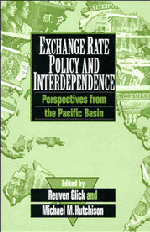Book contents
- Frontmatter
- Contents
- List of contributors
- Preface
- Exchange rate policy and interdependence
- 1 Overview
- I International financial market integration
- 2 Financial links around the Pacific Rim: 1982–1992
- 3 Relative returns on equities in Pacific Basin countries
- 4 Exchange rate policy, international capital mobility, and monetary policy instruments
- II Choice of exchange rate regimes
- III Intervention and sterilization policies
- IV Prospects for a yen bloc
- Index
4 - Exchange rate policy, international capital mobility, and monetary policy instruments
Published online by Cambridge University Press: 04 May 2010
- Frontmatter
- Contents
- List of contributors
- Preface
- Exchange rate policy and interdependence
- 1 Overview
- I International financial market integration
- 2 Financial links around the Pacific Rim: 1982–1992
- 3 Relative returns on equities in Pacific Basin countries
- 4 Exchange rate policy, international capital mobility, and monetary policy instruments
- II Choice of exchange rate regimes
- III Intervention and sterilization policies
- IV Prospects for a yen bloc
- Index
Summary
Introduction
This essay examines the degree of capital mobility confronting a sample of developing countries in the Pacific Basin. An accurate and timely assessment of changes in the degree of capital market integration is important because capital mobility has pervasive implications for economic performance under alternative exchange rate arrangements and monetary policy regimes. It seems likely that these differences are most pronounced during the early stages of integration. Unfortunately, wellknown procedures for evaluating the degree of capital market integration among industrial countries are very difficult to implement during this crucial initial phase of economic transition. The approach taken in this essay requires a minimum of data for domestic interest rates and forward foreign exchange rates. While the approach is attractive because of minimal data requirements, the cost appears to be a difficult problem in identifying endogenous official behavior.
The pace of capital market integration is interesting because governments need a timely measure of integration in order to evaluate policy options. If changes in capital mobility are caused primarily by changes in administrative controls over international financial transactions, the degree of capital market integration can be measured by qualitative evaluation of the rules of the game and the pace of integration can be directly controlled by the government.
If the pace of capital market integration is determined largely by market forces, government policy might still be an important source of incentives for or against integration.
- Type
- Chapter
- Information
- Exchange Rate Policy and InterdependencePerspectives from the Pacific Basin, pp. 68 - 96Publisher: Cambridge University PressPrint publication year: 1994
- 9
- Cited by



